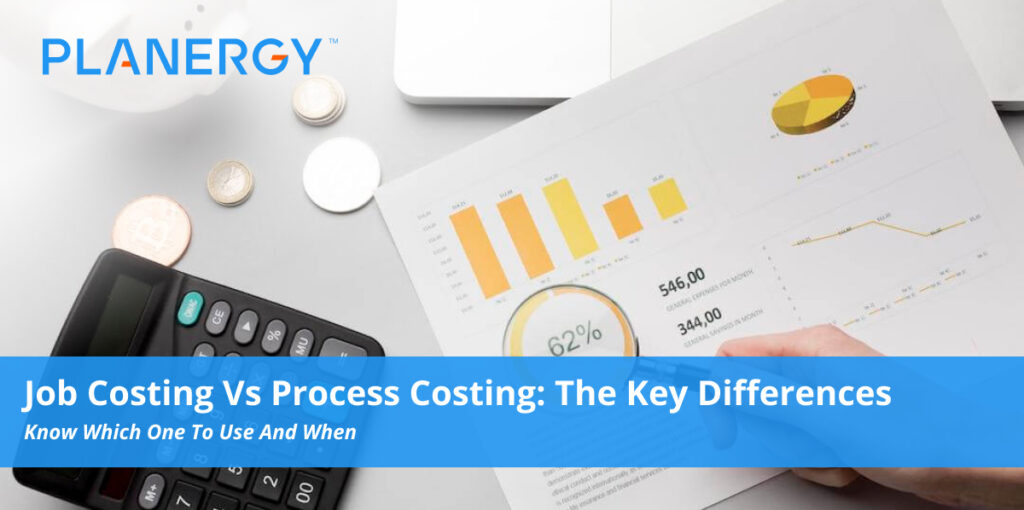Job Costing Vs Process Costing: The Key Differences
Job costing, also known as job order costing, and process costing are cost accounting systems designed to help businesses keep track of all the costs they have to pay to produce a product or deliver a service. The type of costing method you use depends on the type of business you’re running.
What is Job Costing?
With the job costing approach, your business completes work on a project basis. The total cost for each job is different. This is the case for plumbers, mechanics, freelancers, movers, and anyone who works in a trade or provides customers an estimate before doing any work.
If you hire movers to move your items from one home to another – either local or long distance – the moving company will estimate the labor costs, equipment, and anything else they need for the project, along with a profit margin, then provide you with an estimate. Each job is different, depending on the size of the home, whether or not the items are packed ahead of time or to be packed in advance of the move, and the distance between homes.
Each job is a project that has its own distinct entity.
- No job is the same. Each job will have to be done differently to successfully complete it.
- Based on client requirements or needs.
- The difference in work in progress exists in each period.
What is Process Costing?
Process costing is used when the products or services you offer are nearly identical or close to it.
Consider, for instance, a company that manufactures fabric face masks. Making the masks is a process that requires material and labor, and costs are incurred as the product moves through production and from one department to another. The fabric is cut into the correct shape, then each mask is sewn, and then the masks are packaged for shipment.
The majority of companies produce more than one product, and they use process costing by making batches of identical products, or at least highly similar products. Batch 1 might be 1,000 solid black masks, while batch 2 is 1,500 red and white striped masks.
The batches are a little different, and the manufacturer makes slight adjustments to switch between products. The cost to change machine settings and to move in different materials – such as a different type of fabric – is factored into the overhead cost for each product.
The process costing system is easier for business owners because it’s only necessary to track costs for a particular batch of masks. Job costing, on the other hand, requires business owners to manage multiple (sometimes hundreds or more) individual projects.
Setting Up a Costing System
Before you can set up an effective job or processing costing system, you have to separate direct costs from indirect, or overhead costs.
Overhead costs are the most difficult to assign to products, and many businesses struggle to analyze these costs. Overhead costs cannot be directly traced to products or services, which makes them harder to track and manage. Utility costs and insurance premiums are examples.
Direct costs, on the other hand, can easily be traced to specific products or services. If you manufacture face masks, you can calculate the amount of each fabric (raw materials) you use in each mask for direct materials and the direct labor costs it takes to run the machines. Because of this, labor and material costs are considered direct costs.
Blockquote: “The costing system you use determines how expenses are tracked, and may even play a role in how you price your products and services.”
Differences Between Job Costing and Process Costing
- Production: In job costing, production is customized, while it is standardized in process costing.
- Assignment: In job costing, it is calculating the cost of each job. In process costing, the cost is first determined by the process and then decided based on the number of units produced.
- Reduction in Cost: With job costing, there are fewer scopes of reduction in costs; the opposite is true with process costing.
- Cost Transfer: Costs cannot be transferred in job costing, but can be transferred from one process to another in process costing.
- Individuality: Because all jobs are different from each other, all products have individuality in job costing. Because process costing means products are produced in high volume, they lack individuality.
- Industry: Job costing is best for industries where products or services are customized based on consumers’ demands. Process costing is best for mass production industries with standardized products.
- Losses: In job costing, losses are not separated, but with process costing, losses can be separated.
- Work in Progress: With job costing, there may or may not be any work in progress (WIP). With process costing, there is always WIP at the beginning and end of a period.
- Size of Job: Job costing is best for small production units, while process costing is best for large production units.
- Record Keeping: For job costing, keeping records is tedious and time-consuming, but process costing keeps things streamlined and efficient.
Examples
Jennifer – Job Costing System
Jennifer owns and operates AAA Lawn Services, a business that provides landscaping and lawn care services.
When she sends a bid to a potential client, her direct costs include materials and labor expenses. AAA must also assign overhead costs such as the costs related to running the office, insurance premiums, and building lease.
How does Jennifer properly assign overhead costs to each job?
Use a Level of Activity
You can allocate overhead costs based on a level of activity. the logic is that a business incurs costs based on activities like the number of labor hours worked, the total units produced, or the total miles driven. If Jennifer’s company doesn’t produce or sell anything during a particular month, many of our costs would not be incurred.
The next step is to decide on an activity level that causes you to incur each overhead cost. In some instances, there is an obvious connection. You can allocate mileage costs based on the number of miles driven to and from your particular customer’s location for instance.
It’s best to make an effort to connect each overhead cost to a related or at least somewhat related activity.
If Jennifer finds that job A required more labor hours than job B, it makes sense to assign more overhead costs to job a because it took more effort and therefore should be assigned more costs. Though it’s not a perfect allocation, it’s an accepted approach many companies use.
What’s important is that every overhead cost is allocated with the same process and the costs have to be included in each job estimate.
From there, you budget your cost for both direct and overhead. This is crucial to generate job estimates that are as close to your actual cost as possible.
Your actual cost may be different than what you budget. A labor shortage friend since may require you to pay more for labor costs than you initially planned but by thinking carefully and creating budgeted cost, you minimize the differences between your budgeted and actual cost which is the best you can do as a business owner.
You also need to plan your overhead costs. To build your budget, review your income statement and other financial statements for last year. Look at the expense categories and note each overhead cost and the amount spent before. Some of those are fixed costs which can be used to allocate your overhead for this year.
Other overhead costs have to be estimated for purposes of the budget. Mileage cost, for instance, will vary depending on the number of projects Jennifer completes in the distance between each job and the office.
After you’ve budgeted for both direct costs and overhead, you can create useful job estimates, using that budget and an added profit margin.
Hannah – Process Costing System
Hannah owns ABC Clothing, a company that makes apparel for sports and outdoor activities. One of Hannah’s most popular items is a line of women’s t-shirts. Their cotton shirts made with extra layers of fabric and reinforce stitching to prevent tearing but also help wick away moisture.
To implement her process costing system, she computes the cost per specific unit produced. Each type of product produced will have a slightly different cost total.
Just as shown with job costing, Hannah has to create a budget with assumptions about costs. Maybe see clothing half the budget for the cost of materials and make assumptions about wage rates to determine the labor cost.
Hannah’s staff runs machinery to cut the fabric, so the shirts, and a package of the shirts when they are finished.
ABC Clothing then assigns overhead to each product and the process of allocating overhead is the same as in job costing. After Hannah determines her overhead costs and decides on activity level she allocates those costs for each unit. For instance, $10 of each unit cost accounts for the overhead.
Though the overhead allocation process is the same, the types of overhead costs differ from one company to the next. ABC clothing for instance allocates the cost to lease its manufacturing facility based on the number of total clothing units produced. Plumbers or carpenters on the other hand have to allocate overhead cost for mileage driven to work for the clients.
The first money spent in a process costing system is for materials because you purchase the materials before you pay the workers to do something with the materials. Accountants use control accounts to track the cost to go into the manufacturing process.
Staff time cards can be used to track labor costs until they are assigned to production.
When ABC Clothing starts production on a particular batch of shirts, costs are tracked in the work-in-progress account. Costs in this account are actual costs which may differ from your budget.
At this point, Hannah’s company needs to precisely track the material cost and labor costs that are needed to make a batch of shirts. When an employee pulls a new roll of cotton fabric from the shelf to make the shirts (using first in first out, or FIFO to ensure the oldest materials are used first), the cost has to be moved out of material control and into work in process. If a worker incurs 3 hours of time working on batch number 112, the gross wages have to be reclassified from labor control to work-in-process.
To accurately track these process costs, an information system that allows your staff to easily record this activity is crucial. Hannah also has to keep her staff accountable for using these systems every day because if they don’t, the company can’t track product costs.
When a batch of shirts is finished, the total cost to move from work in process inventory to finished goods inventory, which indicates the products are ready for sale.
To make the most of your costing system, create an annual budget and cost for both direct and overhead costs. On a monthly basis, if you use job costing review each completed job and compare the budgeted cost to your actual cost. Investigate the differences you find. If you use process costing review your cost by batch instead of individual job. If you find that actual costing more than 10% higher than your budget, revisit your budget to determine whether or not your assumptions are reasonable.
Using a costing system ultimately gives you better information about your company and operations than your competitors. By understanding all of the actual costs required to deliver your products or services, you know exactly where you stand financially so you can be confident in your pricing and profit generation.




